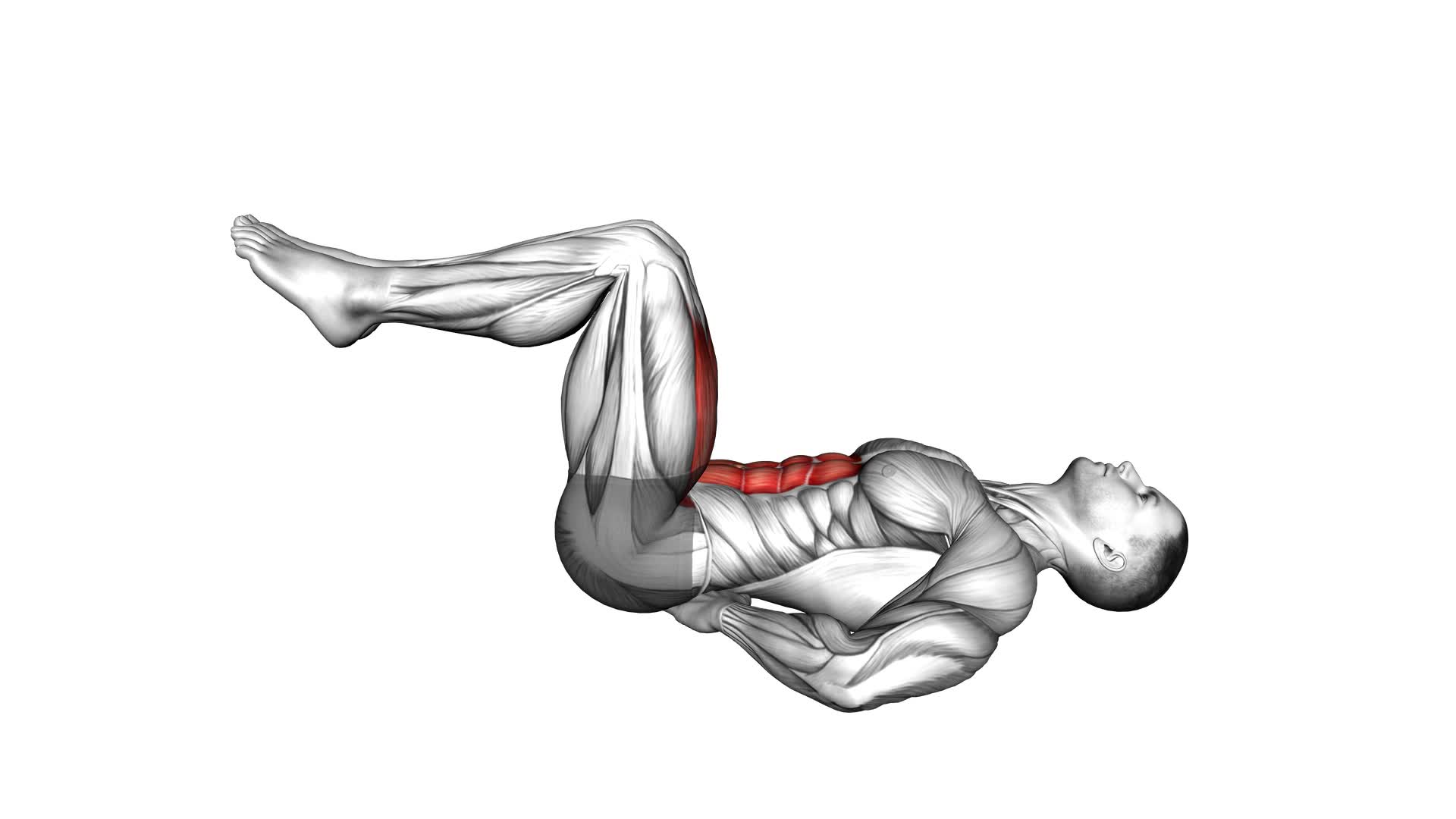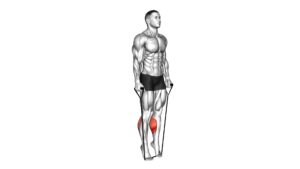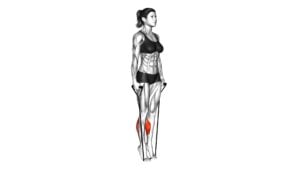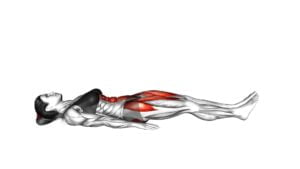Lying Bent Legs Raise – Video Exercise Guide & Tips

Looking to strengthen your core and lower body? Try the Lying Bent Legs Raise!
Watch This Exercise Video
This exercise targets your abs, hips, and thighs for a challenging workout.
In this video exercise guide, we'll show you the correct technique and provide helpful tips to maximize your results.
Get ready to feel the burn and take your fitness routine to the next level with this effective move.
Let's get started!
Key Takeaways
- Lying bent leg raises target the abs, hips, and thighs, improving core activation and lower abdominal strength.
- Proper form is essential to prevent injury and effectively target the muscles.
- Alternative exercises for lower abs include hanging leg raises, reverse crunches, and bicycle crunches.
- Increasing intensity and progression can be achieved by adding ankle weights, elevating the upper body, and gradually increasing weight as strength improves.
Benefits of Lying Bent Legs Raise
You will experience significant core strengthening and hamstring activation with the lying bent legs raise exercise. This exercise primarily targets the lower abdominal muscles, helping to improve core activation and lower abdominal strength.
By lying on your back with your knees bent and feet flat on the floor, you engage your core muscles to lift your legs off the ground. As you raise your legs, you'll feel a deep burn in your lower abdominals. This exercise not only helps to tone and strengthen your core, but it also activates your hamstrings, which are the muscles located on the back of your thighs.
By incorporating the lying bent legs raise into your workout routine, you can effectively strengthen and sculpt your core while also improving your hamstring strength and stability. Make sure to engage your core throughout the exercise and avoid using momentum to lift your legs.
With consistent practice, you'll notice improved core activation and increased lower abdominal strength.
Equipment Needed for Lying Bent Legs Raise
To perform the lying bent legs raise exercise, you'll need a yoga mat or a comfortable surface to lie on. This will provide cushioning and support for your body as you engage in the exercise. It's important to have a stable and comfortable surface to prevent any discomfort or pain during the workout.
In addition to a yoga mat or comfortable surface, there are no specific equipment requirements for this exercise. The lying bent legs raise can be done without the need for any additional equipment. This makes it a convenient and accessible exercise that can be performed anywhere.
However, if you're looking for alternative exercises for your lower abs, there are various options to consider. Some alternatives include hanging leg raises, reverse crunches, or bicycle crunches. These exercises target the lower abs and can be incorporated into your workout routine to add variety and challenge.
Proper form is essential when performing leg raises or any exercise. It helps to prevent injury and ensures that you're targeting the intended muscles effectively. It's important to maintain a slow and controlled movement throughout the exercise, focusing on engaging your core and avoiding any swinging or momentum.
Now that you know the equipment needed for lying bent legs raise and the importance of proper form, let's move on to the step-by-step guide to performing this exercise.
Step-by-Step Guide to Performing Lying Bent Legs Raise
To perform the lying bent legs raise exercise, start by lying flat on your back on a yoga mat or comfortable surface. Here's a step-by-step guide to help you perform this exercise with proper form:
- Bend your knees and place your feet flat on the ground, keeping your feet hip-width apart.
- Rest your arms by your sides, palms facing down.
- Engage your core muscles by drawing your belly button towards your spine.
- Slowly lift both legs off the ground, keeping your knees bent at a 90-degree angle.
- As you raise your legs, exhale and engage your abdominal muscles.
- Pause for a moment at the top of the movement, making sure to keep your lower back pressed into the mat.
- Slowly lower your legs back down to the starting position, inhaling as you do so.
- Repeat for the desired number of repetitions.
To make this exercise more challenging, you can try the following progression techniques:
- Straight leg raises: Instead of keeping your knees bent, extend your legs fully while lifting them off the ground.
- Weighted leg raises: Hold a dumbbell or a medicine ball between your feet as you perform the exercise.
Remember to maintain proper form throughout the exercise to avoid any strain or injury.
Common Mistakes to Avoid During Lying Bent Legs Raise
One common mistake to avoid during the lying bent legs raise exercise is failing to maintain proper alignment of your lower back. It's important to keep your lower back pressed firmly against the floor throughout the movement. This helps to engage your core muscles and prevent strain on your spine.
Another common mistake is using momentum to lift your legs instead of relying on the strength of your abdominal muscles. This not only reduces the effectiveness of the exercise but also increases the risk of injury.
Additionally, be careful not to lift your legs too high, as this can put unnecessary strain on your hip flexors and lower back. Instead, focus on lifting your legs only until they're perpendicular to the floor.
By avoiding these common mistakes and maintaining proper form, you can maximize the benefits of the lying bent legs raise exercise and reduce the risk of injury.
Now, let's move on to some tips to increase intensity and progression in lying bent legs raise.
Tips to Increase Intensity and Progression in Lying Bent Legs Raise
To increase the intensity and progression in lying bent leg raises, there are a few tips you can follow.
One option is to add ankle weights to challenge your muscles further.
Another tip is to elevate your upper body by using a foam roller or an incline bench, which will engage your core muscles and increase the difficulty of the exercise.
Adding Ankle Weights
To increase the intensity and progression in your lying bent legs raise, you can add ankle weights. This simple addition can help you take your exercise to the next level. Here are some tips to consider when using ankle weights:
- Choose the right weight: Start with a weight that challenges you but still allows you to maintain proper form.
- Secure the weights properly: Make sure the ankle weights are securely fastened to your legs to avoid any slipping or discomfort during the exercise.
- Maintain proper form: Keep your core engaged and your back flat on the ground while performing the exercise with ankle weights.
- Start with lighter weights: If you're new to using ankle weights, start with lighter weights and gradually increase the weight as you build strength and endurance.
Elevating the Upper Body
How can you further increase the intensity and progression in your lying bent legs raise by elevating your upper body?
Elevating your upper body during the lying bent legs raise exercise can help to target your upper body muscles and increase the overall challenge of the movement. By elevating your upper body, you engage your upper body strength and core stability even more.
To do this, you can place a small pillow or folded towel under your upper back, just below your shoulder blades. This slight elevation creates a greater demand on your abdominal muscles and forces your upper body to work harder to maintain stability.
As a result, you'll not only build strength in your lower body but also improve your upper body strength and core stability.
Modifications and Variations of Lying Bent Legs Raise
Once you have mastered the basic technique of the lying bent legs raise, you can explore modifications and variations to challenge yourself further. Here are some standing variations and seated modifications you can try:
Standing variations:
- Standing bent legs raise: Stand tall with your feet hip-width apart. Lift one leg and bring your knee towards your chest while keeping the other leg firmly planted on the ground. Lower your leg back down and repeat on the other side.
- Standing alternating bent legs raise: Similar to the previous variation, but alternate lifting one leg at a time. This adds a dynamic element to the exercise.
Seated modifications:
- Seated bent legs raise: Sit on the edge of a chair with your feet flat on the ground. Lean back slightly and lift both legs off the ground, bringing your knees towards your chest. Slowly lower your legs back down.
- Seated bent legs raise with resistance band: Place a resistance band around your thighs, just above your knees. Sit on a chair and lift both legs off the ground, keeping tension in the band. This adds resistance to the exercise, making it more challenging.
Remember to maintain proper form and engage your core throughout these variations and modifications.
Incorporating these exercises into your routine will help target different muscle groups and keep your workouts interesting.
Frequently Asked Questions
How Many Sets and Reps Should I Do for the Lying Bent Legs Raise Exercise?
For optimal training frequency of lying bent leg raises, it's recommended to perform 3 sets of 10 to 15 reps. This will effectively target your lower abdominal muscles and help strengthen your core.
As you progress, you can increase the number of sets or reps to continue challenging yourself. Remember to maintain proper form throughout the exercise and listen to your body to avoid any discomfort or injury.
Can I Perform the Lying Bent Legs Raise Exercise if I Have Lower Back Issues?
If you have lower back issues, it's important to be cautious when performing the lying bent legs raise exercise. It may put strain on your lower back and worsen your condition.
Instead, consider alternative exercises that target your core without putting stress on your lower back. Planks, bird dogs, and pelvic tilts are all great options.
Be sure to consult with a professional for modifications that specifically address your lower back issues.
Is It Necessary to Use a Mat or Can I Perform the Exercise on a Hard Surface?
If you're wondering if it's necessary to use a mat for the lying bent legs raise exercise, the answer is no, it's not necessary.
However, using a mat has its benefits. It provides cushioning and support for your body, especially if you're exercising on a hard surface.
If you don't have a mat, you can modify the exercise by placing a towel or blanket underneath you to make it more comfortable.
Can I Incorporate Weights or Resistance Bands Into the Lying Bent Legs Raise Exercise?
Yes, you can incorporate weights or resistance bands into the lying bent legs raise exercise. Adding resistance will increase the intensity and challenge your muscles even more.
You can use dumbbells or ankle weights for added resistance. Alternatively, you can loop a resistance band around your thighs to provide resistance.
However, if you have lower back issues, it's important to modify the exercise and consult with a professional to ensure proper form and avoid any discomfort or injury.
How Long Should I Rest Between Sets When Performing the Lying Bent Legs Raise Exercise?
When performing the lying bent legs raise exercise, it's important to focus on proper form and give yourself adequate rest intervals between sets. Resting between sets allows your muscles to recover and reduces the risk of injury.
The length of rest intervals can vary depending on your fitness level and goals, but a general guideline is to rest for about 30-90 seconds between sets. Remember to listen to your body and adjust the rest time as needed.
Conclusion
In conclusion, the lying bent legs raise is a beneficial exercise that targets the lower abdominal muscles. By following the step-by-step guide and avoiding common mistakes, you can effectively perform this exercise and increase its intensity over time.
Additionally, modifications and variations of the lying bent legs raise can provide added challenge and variety to your workout routine. Incorporating this exercise into your fitness regimen can help strengthen and tone your core muscles.

Author
Years ago, the spark of my life’s passion ignited in my mind the moment I stepped into the local gym for the first time. The inaugural bead of perspiration, the initial endeavor, the very first surge of endorphins, and a sense of pride that washed over me post-workout marked the beginning of my deep-seated interest in strength sports, fitness, and sports nutrition. This very curiosity blossomed rapidly into a profound fascination, propelling me to earn a Master’s degree in Physical Education from the Academy of Physical Education in Krakow, followed by a Sports Manager diploma from the Jagiellonian University. My journey of growth led me to gain more specialized qualifications, such as being a certified personal trainer with a focus on sports dietetics, a lifeguard, and an instructor for wellness and corrective gymnastics. Theoretical knowledge paired seamlessly with practical experience, reinforcing my belief that the transformation of individuals under my guidance was also a reflection of my personal growth. This belief holds true even today. Each day, I strive to push the boundaries and explore new realms. These realms gently elevate me to greater heights. The unique combination of passion for my field and the continuous quest for growth fuels my drive to break new ground.



